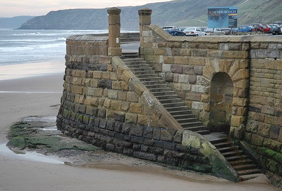This is an article originally published in the Yorkshire Journal (Spring Issue, 2010) by Sarah Harrison. She has kindly given permission for her work to be republished – for Part I of the article please click here.
When the York and North Midland Railway established links with Scarborough in 1845, it became much easier for visitors to reach the town, which, in turn, led to large-scale investment in tourism. However, hotels and entertainment facilities had been increasing steadily since the 1700s, following the discovery of Scarborough’s natural springs in the 1600s.
Left: In the late 1700s, wealthy visitors whiled away the afternoon at the theatre on Tanner Street, now St Thomas Street, where many famous actors performed. In 1825 a seat in the boxes cost three shillings, in the pit two shillings and in the gallery one shilling. The theatre was demolished in 1929 (via the Yorkshire Journal, Spring Issue, 2010)
In 1867 the Grand Hotel was completed – then one of the largest hotels in the world and one of the first in Europe to be purpose-built. Another first for Scarborough was the cliff tram, built in 1875, to link the South Cliff Esplanade to the Scarborough Spa. There would eventually be five cliff lifts in operation – three on the South side and two near the North Sands. Only two operate today – one by the Scarborough Spa (referred to as the South Cliff lift), and the other near at the side of the Grand Hotel (not to be confused with the one pictured below).
Above: The Grand Hotel and the Cliff Bridge. The Cliff Tram in the centre of the photo is now closed (via the Yorkshire Journal, Spring Issue, 2010)
Only eighteen years after the official opening of the Scarborough Spa on 8 September 1876 the building was destroyed by fire and had to be rebuilt. By June 1879 the new Grand Hall was opened to the public, with the formal opening ceremony taking place on August 2nd, 1880. So began a great era of music and entertainment – indeed, a range of leading musicians, conductors and performers all performed at Scarborough Spa.
Additions and alterations have been made over the years and a major restoration programme was carried out in the early 1980s to reinstate some of the original features and decorative styles.
Today the Scarborough Spa complex is a Grade II listed building which includes the Spa Theatre, the Grand Hall for concerts, the Ocean Room, the Promenade Lounge, Sun Court (for open air concerts), and various other rooms. It is also home to the Scarborough Spa Orchestra, the last remaining seaside orchestra in Britain. The orchestra gives 10 concerts every week during the summer months, playing from an extensive repertoire of classical and light music.
Above: Sun Court for open air concerts (via the Yorkshire Journal, Spring Issue, 2010)
Although taking the waters declined in popularity during the 19th century, the Spa’s reputation as a fashionable location for entertainment and relaxation grew in popularity. Also, the chemical composition of the water has altered considerably over the years and so the practice of “Taking the Water” came to an end in the late 1960s.
Above: Steps leading down to the well (via the Yorkshire Journal, Spring Issue, 2010)
Today the only visible evidence of the Spa water – that made Scarborough the first seaside resort in Britain – is a well set in the wall and the steps leading down to the beach on the north side of the Spa Complex. The strong mineral content of the water has stained the wall’s stones a reddish-brown colour. Likewise, it was this same staining that led to the discovery of the waters close to this site back in 1626.
Above: The spa well set in the wall (via the Yorkshire Journal, Spring Issue, 2010)
Today, the spa water is no longer recommended for drinking – there is a sign above the well which reads “Not Drinking Water”. The waters may have changed somewhat, but without Mrs. Farrer’s discovery in the seventeenth century, Scarborough would not have developed into the first English (and arguably, in its time, most famous) seaside resort.. Maybe one day the Spa will open again when the water is safe to drink and the well given a new look.
Sources
For a full list of acknowledgements, and to see the article in its original format, please visit the Yorkshire Journal (Spring, 2010). All copyright retained by the author.
Many thanks to Sarah for sharing this article with Stories From Scarborough!












